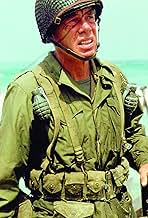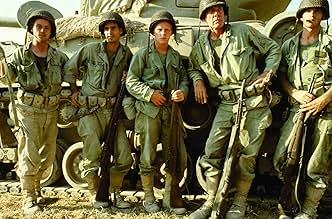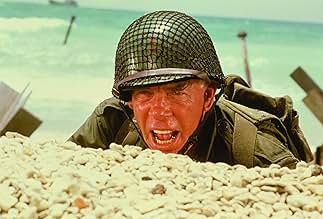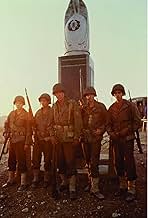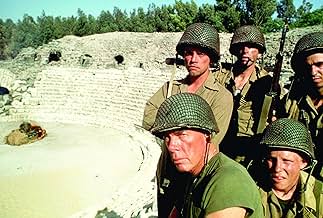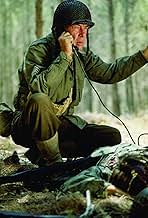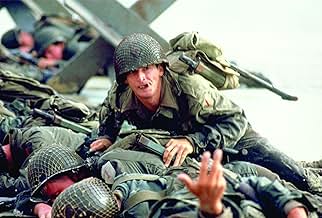IMDb-BEWERTUNG
7,1/10
22.376
IHRE BEWERTUNG
Ein abgehärteter Sergeant und die vier Kernmitglieder seiner Infanterieeinheit versuchen, den Zweiten Weltkrieg zu überleben, während sie in ganz Europa von Schlacht zu Schlacht ziehen.Ein abgehärteter Sergeant und die vier Kernmitglieder seiner Infanterieeinheit versuchen, den Zweiten Weltkrieg zu überleben, während sie in ganz Europa von Schlacht zu Schlacht ziehen.Ein abgehärteter Sergeant und die vier Kernmitglieder seiner Infanterieeinheit versuchen, den Zweiten Weltkrieg zu überleben, während sie in ganz Europa von Schlacht zu Schlacht ziehen.
- Auszeichnungen
- 2 Gewinne & 2 Nominierungen insgesamt
Stéphane Audran
- Underground Walloon Fighter at Asylum
- (as Stephane Audran)
Empfohlene Bewertungen
This review is on the "reconstructed" DVD, a version that came out several years ago, adding 49 minutes to the original 1980 movie. (The film runs 162 minutes, not 158 as stated on the IMDb title page.)
The "old" version was very good, and this newer version makes the film even better. Either way, you have a solid war movie.
For men - and that's who will primarily watch this movie because it's a guy's flick with no romance and no women leads - this keeps the action coming, but without overdoing it. You can different kinds of action scenes, too, not just people shooting at one another.
I also appreciated the photography. It's a good visual movie. The added footage looked sharper and clearer than the previously shown, but either way it was nicely filmed and directed. Of course, the director is the famous Sam Fuller, who did a number of tough film noirs, among other things.
Speaking of tough, the person who makes this movie a notch above average is Lee Marvin. He is just excellent as the tough-on-the-outside-but-soft-hearted underneath commanding officer, known only as "The Sergeant." With his deep voice and weathered face, Marvin makes for an effective leader of tough guys. The language was much milder in here than you find in more modern films, although it can be crude in a few spots. There are no f-words and about seven usages of the Lord's name in vain. However, there are a number of sexual references, some crude but, hey, that's "guy talk." All the young soldiers were good, too. It was especially interesting to see baby-faced Star Wars' star, Mark Hamill, playing one of the soldiers in the unit called "The Big Red One."
The story with narration by one of the soldiers, tells of Marvin and his handful of men who travel and do battle from North Africa to Sicily, then Italy, the beaches of Normandy on D- Day and into Germany in addition to a few other memorable stops such as "an insane asylum."
It's long, but I never found it boring and the men never stay too long in one spot.
The "old" version was very good, and this newer version makes the film even better. Either way, you have a solid war movie.
For men - and that's who will primarily watch this movie because it's a guy's flick with no romance and no women leads - this keeps the action coming, but without overdoing it. You can different kinds of action scenes, too, not just people shooting at one another.
I also appreciated the photography. It's a good visual movie. The added footage looked sharper and clearer than the previously shown, but either way it was nicely filmed and directed. Of course, the director is the famous Sam Fuller, who did a number of tough film noirs, among other things.
Speaking of tough, the person who makes this movie a notch above average is Lee Marvin. He is just excellent as the tough-on-the-outside-but-soft-hearted underneath commanding officer, known only as "The Sergeant." With his deep voice and weathered face, Marvin makes for an effective leader of tough guys. The language was much milder in here than you find in more modern films, although it can be crude in a few spots. There are no f-words and about seven usages of the Lord's name in vain. However, there are a number of sexual references, some crude but, hey, that's "guy talk." All the young soldiers were good, too. It was especially interesting to see baby-faced Star Wars' star, Mark Hamill, playing one of the soldiers in the unit called "The Big Red One."
The story with narration by one of the soldiers, tells of Marvin and his handful of men who travel and do battle from North Africa to Sicily, then Italy, the beaches of Normandy on D- Day and into Germany in addition to a few other memorable stops such as "an insane asylum."
It's long, but I never found it boring and the men never stay too long in one spot.
A lot of people hate The Big Red One. They call it farcical, uneven, clichéd. They find it farcical, I believe, because the film revels in the absurdity of war rather than gloss over it. They would rather watch a film, like Saving Private Ryan, which ignores absurdity in favor of violence. These people find it uneven because the "important scenes" (like the D-Day and North African invasion) take only a minute or two to conclude, while other scenes, less typical of a war movie, spread out before us. They call it clichéd because the movie is unsubtle in its treatment of character development and plot.
I cannot agree with these beliefs. The Big Red One is not only one of the greatest WWII films, it is also one of the greatest war movies.
Sam Fuller's film, which was butchered by the studio, is the picaresque tale of 5 members of the First Infantry, known, because of their shoulder patch, as the Big Red One. The film moves from one story to the next without spending too much time on any particular tale.
The individual vignettes, as they must, vary in quality, but on the whole are excellent. The Big Red One stirs within you a desire to run right out and tell your friends about this amazing scene or that.
There's the soldier who loses his testicle, the birthing scene in the belly of a tank, Lee Marvin, in Middle Eastern garb, traipsing across a beach, soldiers dug into holes over which a Panzer tank division travels, the entire Mad House segment... The list goes on.
Some people dislike the absurdest nature of several of this film's stories, but, for me, those surreal touches make this film great.
Without them (and there are a lot), you would be left with a very normal and very boring film. Using bandoleers as stirrups is genius, as is the woman faking crazy as she whirls through a monastery, slicing German throats.
The performances are solid, for this type of film, but if you are looking for subtlety, go elsewhere. Each character is drawn in broad strokes; you never learn too much about them, but you learn enough to understand who they are and why. Lee Marvin, as usual, is amazing. He is one of the great, gruff actors of our time, bringing a special, intangible quality to every film in which I've seen him. He makes every movie he's in better just by showing up. There are too few actors about whom you can say that.
Like the acting, the direction is masculine, but, for a war movie, that's a compliment. In some ways, Fuller's direction here and in his other films reminds me of Hemmingway's writing - terse and effective. Both men believe in an economy of shots or words, depending on their medium, but, through that economy, they attain a muscular sort of poetry akin to the beauty of a horse's rippling muscles as it races on a plain. Fuller's direction here, though not his best when compared to Underworld USA or Shock Corridor, is still better than most, especially considering that this was his first film in several years.
All in all, I find the Big Red One to be an exemplary war movie, even in its emasculated format (I cannot wait to see the restored, 140 minute print, which should improve upon scenes that feel to brief in this version). It's certainly no Apocalypse Now, but it puts to shame most World War II epics before or since.
I cannot agree with these beliefs. The Big Red One is not only one of the greatest WWII films, it is also one of the greatest war movies.
Sam Fuller's film, which was butchered by the studio, is the picaresque tale of 5 members of the First Infantry, known, because of their shoulder patch, as the Big Red One. The film moves from one story to the next without spending too much time on any particular tale.
The individual vignettes, as they must, vary in quality, but on the whole are excellent. The Big Red One stirs within you a desire to run right out and tell your friends about this amazing scene or that.
There's the soldier who loses his testicle, the birthing scene in the belly of a tank, Lee Marvin, in Middle Eastern garb, traipsing across a beach, soldiers dug into holes over which a Panzer tank division travels, the entire Mad House segment... The list goes on.
Some people dislike the absurdest nature of several of this film's stories, but, for me, those surreal touches make this film great.
Without them (and there are a lot), you would be left with a very normal and very boring film. Using bandoleers as stirrups is genius, as is the woman faking crazy as she whirls through a monastery, slicing German throats.
The performances are solid, for this type of film, but if you are looking for subtlety, go elsewhere. Each character is drawn in broad strokes; you never learn too much about them, but you learn enough to understand who they are and why. Lee Marvin, as usual, is amazing. He is one of the great, gruff actors of our time, bringing a special, intangible quality to every film in which I've seen him. He makes every movie he's in better just by showing up. There are too few actors about whom you can say that.
Like the acting, the direction is masculine, but, for a war movie, that's a compliment. In some ways, Fuller's direction here and in his other films reminds me of Hemmingway's writing - terse and effective. Both men believe in an economy of shots or words, depending on their medium, but, through that economy, they attain a muscular sort of poetry akin to the beauty of a horse's rippling muscles as it races on a plain. Fuller's direction here, though not his best when compared to Underworld USA or Shock Corridor, is still better than most, especially considering that this was his first film in several years.
All in all, I find the Big Red One to be an exemplary war movie, even in its emasculated format (I cannot wait to see the restored, 140 minute print, which should improve upon scenes that feel to brief in this version). It's certainly no Apocalypse Now, but it puts to shame most World War II epics before or since.
"The Big Red One" is an episodic war movie from maverick American filmmaker Samuel Fuller. Having only seen "Shock Corridor" from the director's oeuvre, I didn't know what to expect from him this time around. It becomes obvious pretty quickly that Fuller was never going to be a mainstream filmmaker. There's something about his style that's really off-putting. You empathise with the camera, not the actors. It's like they're at odds with each other.
This is not a bad thing, as you can tell from the enthusiastic reception Fuller's movies have gotten here on IMDB. But "The Big Red One" is also drastically cut down from the original print Fuller had, and I wonder if that's why it feels so disjointed.
Of course, it is supposed to be episodic, but I don't know. I didn't really get into it.
This is not a bad thing, as you can tell from the enthusiastic reception Fuller's movies have gotten here on IMDB. But "The Big Red One" is also drastically cut down from the original print Fuller had, and I wonder if that's why it feels so disjointed.
Of course, it is supposed to be episodic, but I don't know. I didn't really get into it.
I have seen this film quite a few times and have always been somewhat puzzled about it. There was no doubt that it had some of the most emotive scenes of any war film but seemed fractured. At times there seemed to be far more realism in it's morality than other films which was understandable since Sam Fuller actually served with The Big Red One at this time so much of it is a first hand account of events and attitudes. I have now read some of the background to the making of the film,I think in the L.A. Times,which now makes sense of the flaws in the film. Apparently Sam Fuller's budget was cut to the minimum by the studios after a regime change and the original screenplay as shot was hacked to death by the same studio against Fuller's wishes. This was not the film he wanted to make but he made it. And it was not the film that he shot as is indicated by the very complete screenplay notes he made. I think it is Richard Schickel, the noted reviewer of Time magazine, who has laboured to find the missing outtakes and to put the film together in its complete form with over 40 minutes added to the length. Apparently this more complete cut significantly improves the film and adheres to Sam Fullers screenplay more accurately. This new cut is now playing to limited audiences and, hopefully, will be available on DVD. It must be emphasized that this is not the film that Fuller originally wanted to make as the budget was cut by 75%. Some of the comments made by other reviewers on these pages are valid as to authenticity specifically in battle scenes. But Fuller did not have the budget that both the Longest Day and Saving Private Ryan had. It will be interesting to see the new cut. Hopefully it will flesh out what could have been one of the greatest Second World War films.
Perhaps I am an exception but this film really did nothing for me.
The premise is simple: the experiences of a US infantry squad led by Lee Marvin fighting in Europe and North Africa during WW II. It was supposed to be about the experiences of the men who fought but I didn't feel the film delivered that: none of the characters were really explored or given much depth, even the great Lee Marvin seemed distant and cold. There isn't too much dialogue, in fact there isn't too much of anything in this film. Its just there but it doesn't really give you much, it just leaves you cold. The plot is occasionally just plain weird and confusing, not the good kind of quirky type of weird but just strange for no apparent reason and with no charm to it.
The action scenes are average, nothing special but enough for their purpose. What annoyed me was that so many different locations were so obviously filmed in the same sandy country (Israel) and it just didn't come off as very convincing. I didn't believe that what I was being shown was really the place it was supposed to be. Its also a quiet film, with very minimal music which in itself isn't bad but just gave the whole thing a somewhat sleepy atmosphere. I wouldn't go so far as to say the film was boring, it wasn't but it just wasn't that attention grabbing either.
Its a film that is there but it did absolutely nothing for me. Others however might enjoy it.
The premise is simple: the experiences of a US infantry squad led by Lee Marvin fighting in Europe and North Africa during WW II. It was supposed to be about the experiences of the men who fought but I didn't feel the film delivered that: none of the characters were really explored or given much depth, even the great Lee Marvin seemed distant and cold. There isn't too much dialogue, in fact there isn't too much of anything in this film. Its just there but it doesn't really give you much, it just leaves you cold. The plot is occasionally just plain weird and confusing, not the good kind of quirky type of weird but just strange for no apparent reason and with no charm to it.
The action scenes are average, nothing special but enough for their purpose. What annoyed me was that so many different locations were so obviously filmed in the same sandy country (Israel) and it just didn't come off as very convincing. I didn't believe that what I was being shown was really the place it was supposed to be. Its also a quiet film, with very minimal music which in itself isn't bad but just gave the whole thing a somewhat sleepy atmosphere. I wouldn't go so far as to say the film was boring, it wasn't but it just wasn't that attention grabbing either.
Its a film that is there but it did absolutely nothing for me. Others however might enjoy it.
Wusstest du schon
- WissenswertesThe bulk of the picture was shot in Israel, and director Samuel Fuller remarked that it was unsettling after a scene was shot when the German soldiers and SS troops would take off their helmets and Fuller would see them wearing yarmulkes; also, between takes they would be sitting around the set in full Nazi uniform speaking Hebrew or reading the Torah.
- PatzerDuring the WW1 scene between the Sergeant and the officer in the dug-out, the Sergeant learns that the armistice had been signed 4 hours previously at 1100hrs, November 11, 1918. While talking with the officer, the sergeant is cutting a piece of red cloth in the shape of a number '1' which he says he will submit as a proposed insignia for the division. However the shoulder sleeve insignia for the 1st Division consisting of a red number "1" was already approved on 31 Oct 1918.
- Zitate
Johnson: [concerning a woman in labor] How do you say "push" in French?
The Sergeant: Poussez.
Johnson: [to woman] Pussy! Pussy! Pussy!
- Alternative VersionenIn 2004, film critic Richard Schickel restored this film to a new director's cut length of approximately 160 minutes. Using Samuel Fuller's production notes and the full-length, unexpurgated script, Schickel restored the footage that was forced to be cut by the studio upon its original 1980 release (which runs 116 minutes). The restored version's DVD release date is 3 May 2005. This longer, epic-length version is closer to Fuller's original vision for the film.
- VerbindungenFeatured in A tout coeur: Folge vom 7. Mai 1984 (1984)
- SoundtracksHorst-Wessel-Lied
Written by Horst Wessel
Top-Auswahl
Melde dich zum Bewerten an und greife auf die Watchlist für personalisierte Empfehlungen zu.
Details
- Erscheinungsdatum
- Herkunftsland
- Sprachen
- Auch bekannt als
- Más allá de la gloria
- Drehorte
- Produktionsfirmen
- Weitere beteiligte Unternehmen bei IMDbPro anzeigen
Box Office
- Budget
- 4.500.000 $ (geschätzt)
- Bruttoertrag in den USA und Kanada
- 7.206.220 $
- Weltweiter Bruttoertrag
- 7.206.823 $
- Laufzeit
- 1 Std. 53 Min.(113 min)
- Farbe
- Sound-Mix
- Dolby Stereo(original release)
- Seitenverhältnis
- 1.85 : 1
Zu dieser Seite beitragen
Bearbeitung vorschlagen oder fehlenden Inhalt hinzufügen


